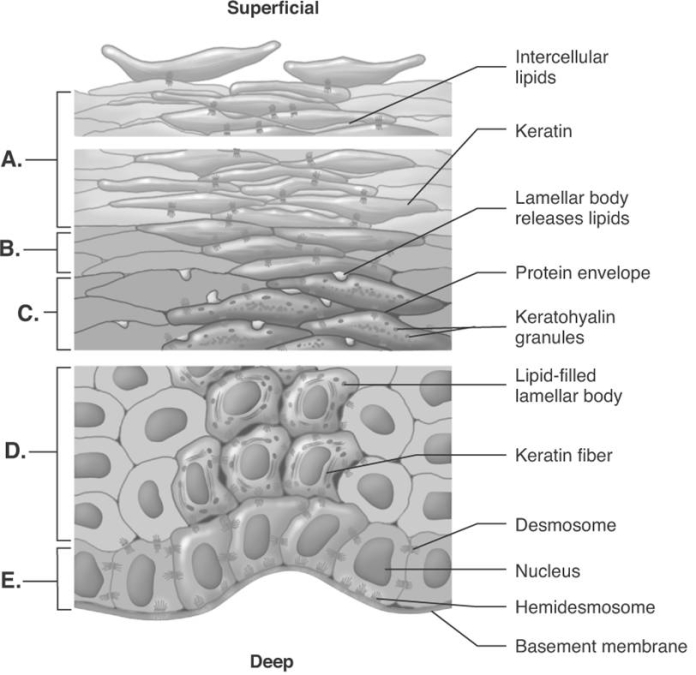A) body temperature homeostasis.
B) body structure.
C) blood volume.
D) brain activity.
E) blood pH.
G) A) and D)
Correct Answer

verified
Correct Answer
verified
Multiple Choice
Which of the following is an inflammatory condition of the skin?
A) melanosomes.
B) albinism.
C) dermatitis.
D) carotene.
E) cyanosis.
G) B) and C)
Correct Answer

verified
Correct Answer
verified
Multiple Choice
The nail root and the nail body attach to the
A) lunula.
B) nail bed.
C) nail groove.
D) hyponychium.
E) hypodermis.
G) D) and E)
Correct Answer

verified
Correct Answer
verified
Multiple Choice
Melanin is produced only by
A) keratinocytes.
B) basal cells.
C) Langerhans cells.
D) melanocytes.
E) Merkel's cells.
G) C) and D)
Correct Answer

verified
Correct Answer
verified
Multiple Choice
 -The figure illustrates keratinization in the epidermis. What layer of the epidermis is "B"?
-The figure illustrates keratinization in the epidermis. What layer of the epidermis is "B"?
A) stratum spinosum
B) stratum corneum
C) stratum basale
D) stratum lucidum
E) stratum granulosum
G) All of the above
Correct Answer

verified
Correct Answer
verified
Multiple Choice
Acne is caused by
A) testosterone.
B) sebum.
C) abnormal keratinization of hair follicles.
D) Propionibacterium.
E) All of these are factors.
G) B) and D)
Correct Answer

verified
Correct Answer
verified
Multiple Choice
Which of the following statements is true?
A) In males, the hairs of the beard are vellus hairs.
B) Both vellus and terminal hairs are pigmented.
C) The majority of hair on the chest is vellus hair.
D) At puberty, much of the vellus hair is replaced with terminal hair.
E) Hair in the axillary region is vellus hair after puberty.
G) B) and C)
Correct Answer

verified
Correct Answer
verified
Multiple Choice
The vesicles that contain melanin are
A) melanosomes.
B) albinism.
C) dermatitis.
D) carotene.
E) cyanosis.
G) A) and B)
Correct Answer

verified
Correct Answer
verified
Multiple Choice
Which of the following is NOT a complication of a major burn?
A) local edema
B) shock
C) increased immunity
D) decreased heart pumping ability
E) venous thrombosis
G) All of the above
Correct Answer

verified
Correct Answer
verified
Multiple Choice
This layer of skin is composed of keratinocytes.
A) epidermis
B) reticular layer
C) papillary layer
D) stretch marks
E) hypodermis
G) A) and B)
Correct Answer

verified
Correct Answer
verified
Multiple Choice
What type of burn appears red and swollen along with pain and blisters?
A) first-degree
B) second-degree
C) third-degree
D) fourth-degree
E) partial-thickness
G) A) and E)
Correct Answer

verified
Correct Answer
verified
Multiple Choice
Skin color is the result of the
A) quantity of melanin in the skin.
B) number of keratinocytes in the skin.
C) amount of fat in the hypodermis.
D) thickness of the stratum basale.
E) number of melanocytes in the skin.
G) B) and C)
Correct Answer

verified
Correct Answer
verified
Multiple Choice
A slight sunburn is an example of a ______ burn.
A) first-degree
B) second-degree
C) third-degree
D) fourth-degree
E) partial-thickness
G) B) and C)
Correct Answer

verified
Correct Answer
verified
Multiple Choice
At birth the hairs of the scalp, eyelids, and eyebrows are replaced by coarser pigmented hairs called
A) terminal hairs.
B) primary hairs.
C) lanugo hairs.
D) vellus hairs.
E) pubic hairs.
G) D) and E)
Correct Answer

verified
Correct Answer
verified
Multiple Choice
The stratum basale
A) is easily shed when you rub your hands together.
B) has a mixture of living and dead cells - mostly dead.
C) contains many blood vessels that nourish the epidermis.
D) contains cells that undergo mitosis to form new epidermal cells.
E) contains cells that undergo meiosis to form new epidermal cells.
G) C) and D)
Correct Answer

verified
Correct Answer
verified
Multiple Choice
Which type of skin cancer is the most common?
A) basal cell carcinoma
B) squamous cell carcinoma
C) melanoma
D) Kaposi's sarcoma
E) psoriasis
G) D) and E)
Correct Answer

verified
Correct Answer
verified
Multiple Choice
The length of hair is determined by the
A) size of the hair bulb.
B) angle of the hair root.
C) rate of hair growth.
D) length of the resting stage.
E) age of the person.
G) A) and E)
Correct Answer

verified
Correct Answer
verified
Multiple Choice
The distal portion of the nail is the
A) nail root.
B) nail body.
C) nail fold.
D) eponychium.
E) hyponychium.
G) A) and B)
Correct Answer

verified
Correct Answer
verified
Multiple Choice
The bluish tinge of skin due to a reduction of oxygen in the blood is called
A) hemolysis.
B) desquamation.
C) cyanosis.
D) carotenosis.
E) albinism.
G) B) and D)
Correct Answer

verified
Correct Answer
verified
Multiple Choice
Thick skin
A) has three different epidermal strata.
B) has fewer layers of cells in the stratum corneum than thin skin.
C) is found covering most of the body.
D) is found in areas subject to pressure or friction such as palms.
E) is determined by the thickness of the dermis.
G) A) and E)
Correct Answer

verified
Correct Answer
verified
Showing 101 - 120 of 139
Related Exams